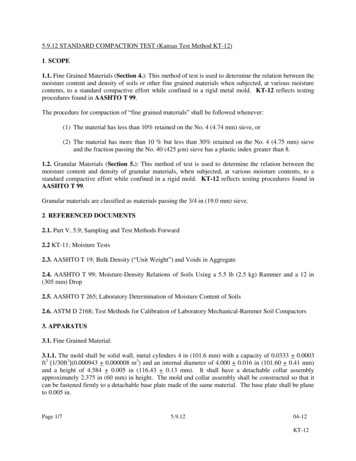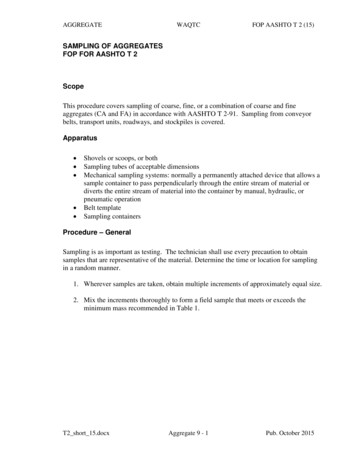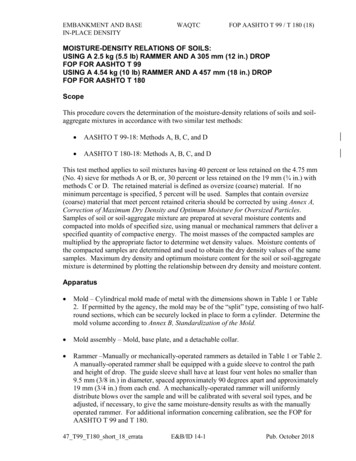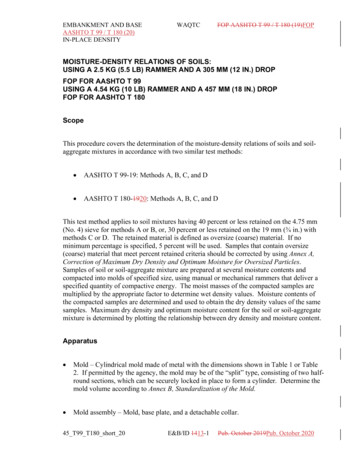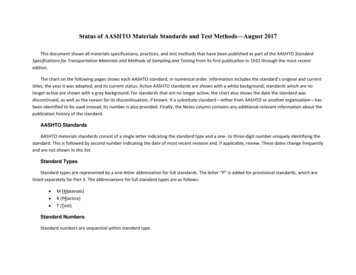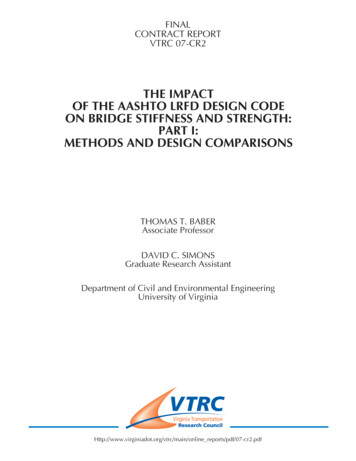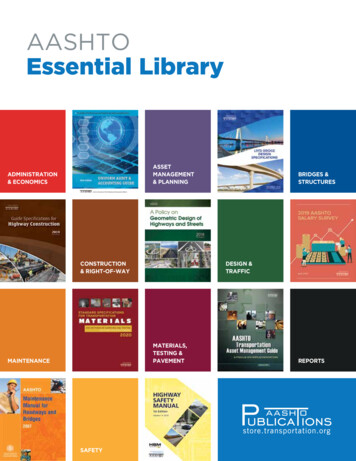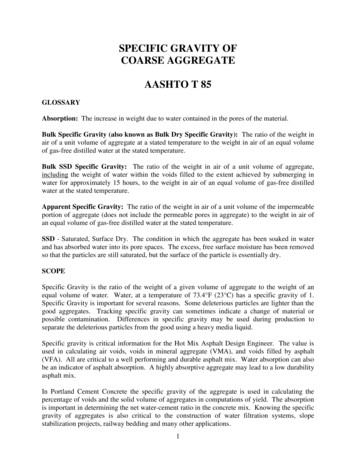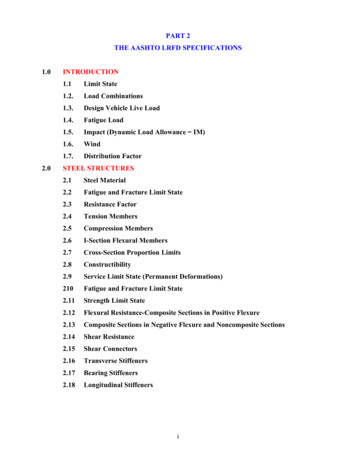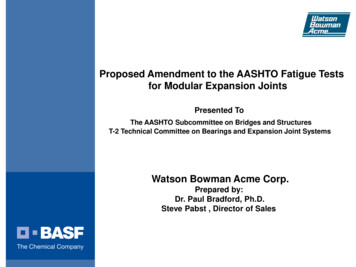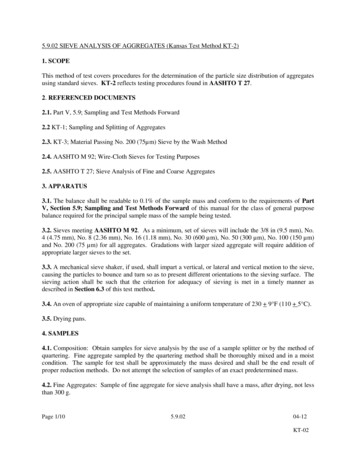
Transcription
5.9.02 SIEVE ANALYSIS OF AGGREGATES (Kansas Test Method KT-2)1. SCOPEThis method of test covers procedures for the determination of the particle size distribution of aggregatesusing standard sieves. KT-2 reflects testing procedures found in AASHTO T 27.2. REFERENCED DOCUMENTS2.1. Part V, 5.9; Sampling and Test Methods Forward2.2 KT-1; Sampling and Splitting of Aggregates2.3. KT-3; Material Passing No. 200 (75µm) Sieve by the Wash Method2.4. AASHTO M 92; Wire-Cloth Sieves for Testing Purposes2.5. AASHTO T 27; Sieve Analysis of Fine and Coarse Aggregates3. APPARATUS3.1. The balance shall be readable to 0.1% of the sample mass and conform to the requirements of PartV, Section 5.9; Sampling and Test Methods Forward of this manual for the class of general purposebalance required for the principal sample mass of the sample being tested.3.2. Sieves meeting AASHTO M 92. As a minimum, set of sieves will include the 3/8 in (9.5 mm), No.4 (4.75 mm), No. 8 (2.36 mm), No. 16 (1.18 mm), No. 30 (600 µm), No. 50 (300 µm), No. 100 (150 µm)and No. 200 (75 µm) for all aggregates. Gradations with larger sized aggregate will require addition ofappropriate larger sieves to the set.3.3. A mechanical sieve shaker, if used, shall impart a vertical, or lateral and vertical motion to the sieve,causing the particles to bounce and turn so as to present different orientations to the sieving surface. Thesieving action shall be such that the criterion for adequacy of sieving is met in a timely manner asdescribed in Section 6.3 of this test method.3.4. An oven of appropriate size capable of maintaining a uniform temperature of 230 9 F (110 5 C).3.5. Drying pans.4. SAMPLES4.1. Composition: Obtain samples for sieve analysis by the use of a sample splitter or by the method ofquartering. Fine aggregate sampled by the quartering method shall be thoroughly mixed and in a moistcondition. The sample for test shall be approximately the mass desired and shall be the end result ofproper reduction methods. Do not attempt the selection of samples of an exact predetermined mass.4.2. Fine Aggregates: Sample of fine aggregate for sieve analysis shall have a mass, after drying, not lessthan 300 g.Page 1/105.9.0204-12KT-02
4.3. Coarse Aggregate: Samples of coarse aggregate and mixtures of coarse and fine aggregate for sieveanalysis shall have a mass, after drying, not less than the amounts indicated in Table 1.Table 1Sample Size for Determination ofCoarse Aggregate Gradation TestsSieve Size2 1/2 in (63 mm) or more2 in (50 mm)1 1/2 in (37.5 mm)1 in (25.0 mm)3/4 in (19.0 mm)1/2 in (12.5 mm)3/8 in (9.5 mm) or lessMinimum Mass of Samples (g)35,00020,00015,00010,0005,0002,0001,000NOTE: To select the sample size, use the largest sieve on which 5% or more of the material is specifiedto be retained.NOTE: 12.00 in (300 mm) diameter sieves should be used for testing coarse aggregates and in testingsamples with a mass of 5,000 g or more. If 12.00 in (300 mm) diameter sieves are not available, the splitsample procedure in Section 7.3 of this test method shall be used.5. PREPARATION OF SAMPLES5.1. Dry all samples to a constant mass at a temperature of 230 9 F (110 5 C). Determine the mass ofthe sample to the nearest 0.1%. Record this as the original dry mass.NOTE: Aggregate for Concrete (except Lightweight), Underdrains and Crushed Stone for backfill shallhave clay lumps retained on the No. 4 (4.75 mm) sieve removed and discarded from the sample before theoriginal mass of the sample is determined.5.1.1. In the case of Cold in Place Recycle, air drying is acceptable.5.2. Samples containing material finer than the No. 200 (75µm) sieve shall be washed over the No. 200(75µm) sieve as specified in KT-3, Section 5.2. Then redry the sample to constant mass. Determine themass of the sample to the nearest 0.1% of the original dry mass. Record this as the dry mass of sampleafter washing.NOTE: Aggregate for Cover Material, Subgrade Modification, Surfacing or Resurfacing or Surfacing orSubgrade modification for Secondary Roads and Aggregates for Ice Control, shall have all deleteriousmaterial including clay lumps retained on the No. 4 (4.75 mm) sieve removed and discarded from thesample before the mass of the sample after washing is determined.5.3. For convenience, mixtures of coarse and fine aggregates may be separated into two portions byscreening the dried sample over a No. 4 (4.75 mm) sieve.Page 2/105.9.0204-12KT-02
5.3.1 Reduce the material passing the No. 4 (4.75 mm) sieve by means of a sample splitter to a mass ofapproximately 1,000 g. Wash both the coarse and reduced fine portions of the total sample in accordancewith KT-3, Section 5.2, and conduct a sieve analysis on each portion. Calculate the total combinedgrading in accordance with subsection Section 7.3 of this test method.6.1 TEST PROCEDURES6.1. Nest the sieves in order of decreasing size of opening from top to bottom and place the sample, orportion of the sample, if it is to be sieved in more than one increment, on the top sieve. Agitate the sievesby hand or by mechanical apparatus for a sufficient period, established by trial or checked bymeasurement on the actual test sample, to meet the criterion for adequacy of sieving described in Section6.3. of this test method.6.2. Limit the quantity of material on a given sieve so that all particles have opportunity to reach sieveopenings a number of times during the sieving operation. For sieves with openings smaller than No. 4(4.75 mm) the mass retained on any sieve at the completion of the sieving operation shall not exceed 4g/in2 (7 kg/m2) of sieving surface. For sieves with openings No. 4 (4.75 mm) and larger, the mass inkg/m2 of sieving surface shall not exceed the product of 2.5 times the sieve opening in mm. In no caseshall the mass be so great as to cause permanent deformation of the sieve cloth.NOTE: The 4 g/in2 (7 kg/m2) amounts to 194 g for the usual 8 in (203 mm) diameter sieve. The amountof material retained on a sieve may be regulated by (1) the introduction of a sieve with larger openingsimmediately above the given sieve or (2) testing the sample in a number of increments.6.3. Continue sieving for a sufficient period and in such a manner that, after completion, not more than0.5% by mass of the total sample passes any sieve during one minute of continuous hand sievingperformed as follows: Hold the individual sieve, provided with a snug fitting pan and cover, in a slightlyinclined position in one hand. Strike the side of the sieve sharply and with an upward motion against theheel of the other hand at the rate of about 150 times per minute, turn the sieve about one-sixth of arevolution at intervals of about 25 strokes. In determining sufficiency of sieving for sizes larger than theNo. 4 (4.75 mm) sieve, limit the material on the sieve to a single layer of particles. If the size of themounted testing sieves makes the described sieving motion impractical, use 8 in (203 mm) diametersieves to verify the sufficiency of sieving.6.3.1. 1 An alternative to maintain a snug fitting pan and cover is to sieve the material over an oversizedpan. The pan must be large enough to ensure all material is retained during the hand sieving process.Any material leaving the sieve over the top of the rim must be returned to the sieve.6.4. In the case of coarse and fine aggregate mixtures, the portion of the sample finer than the No. 4 (4.75mm) sieve may be distributed among two or more sets of sieves to prevent overloading of individualsieves.6.4.1. Alternatively, the portion finer than the No. 4 (4.75 mm) sieve may be reduced in size using amechanical splitter according to KT-1, Section 4.2. If this procedure is followed, compute the mass ofeach size increment of the original sample as outlined in Section 7.3. of this test method.6.5. Determine the mass of each sieve size increment to the nearest 0.1% of the total original dry samplemass (as define in Section 5.1. of this test method) by weighing on a scale or balance conforming to the16.3.1. is not found in AASHTO T 27 but provides a realistic approach to monitoring material falling thru the sieve.Page 3/105.9.0204-12KT-02
requirements specified in Section 3.1. of this test method. The total mass of the material after sievingshould check closely with original mass of sample placed on the sieves. If the amounts differ by morethan 0.3%, based on the original mass of sample placed on the sieves, the results should not be used foracceptance purposes.6.6. If the sample has previously been tested by KT-3, add the mass finer than the No. 200 (75 μm) sievedetermined by that method to the mass passing the No. 200 (75 μm) sieve by dry sieving of the samesample in this method.7. CALCULATIONS7.1. This method applies to aggregates for the following uses: Concrete (except lightweight aggregates which is determined by dry screening).(SCA-, CPA-, FA-) Asphalt Mixtures. (SM-) Hot Recycle Mixtures. (SR-) Maintenance Repair Aggregate. (MRA-) Aggregate Base Construction. (AB-) Portland Cement Treated Base. Granular Sub-base. Underdrains (wash over No. 100 (150 µm) sieve). (BD-)(UD-) Slurry Seal. Shoulder Construction. (AS-) Crushed Stone for Backfill. Riprap, Wash Checks, etc. Cold in Place Recycle.Calculate the total percent of material retained on each sieve as follows:Percent Retained Percent Passing No. 200 (75 µm) 00 ()ryass of amp e7.2. This method applies to aggregates for the following uses: Cover Material (except lightweight aggregate which is determined by dry screening). (CM-) Subgrade Modification. (SR-) Surface or Resurfacing. (SA-) Surfacing or Subgrade Modification for Secondary Roads. (SS-) Aggregates for Ice Control. (AIC-)Calculate the total percent retained on each sieve as follows:Percent Retained Page 4/105.9.0204-12KT-02
ry00 ( ass etained)ass of amp e after ashingPercent Passing No. 200 (75 µm) 00 (*assry ass of amp e after)ashing*Individual Mass Retained – NOT Cumulative7.3. Instructions for using split sample procedure (KDOT Form #645):7.3.1. Record the total dry mass of sample before separation as A.7.3.2. Record the total dry mass of material retained on No. 4 (4.75 mm) sieve following separation as B.7.3.3. Record the total dry mass of material passing the No. 4 (4.75 mm) sieve following separation as C.C A-B7.3.4. Record reduced mass of material passing the No. 4 (4.75 mm) sieve as D.7.3.5. Compute percent of material passing the No. 4 (4.75 mm) sieve as follows:Where :E percent of material passing the No. 4 (4.75 mm) sieve in the total sample.7.3.6. Wash the plus No. 4 (4.75 mm) portion of the sample over the No. 200 (75 µm) sieve as specifiedin KT-3, dry to a constant mass. Weigh and record the mass. Conduct sieve analysis using all regularsieves including the No. 200 (75 µm). Compute the percent of material retained on each sieve as follows:Where:G Total percent of the entire sample that is retained on each sieve.F Total mass of the plus No. 4 (4.75mm) material retained on each sieve size.Calculate the total percent of material finer than the No. 200 (75 μm) sieve for the plus No. 4 fraction ofthe original sample by adding the mass determined by KT-3 to the mass passing the No. 200 (75 μm)sieve by dry sieving, multiplying by 100 and divide by total dry mass of the sample before separation:Where:Page 5/10Q Total percent of the plus No. 4 (4.75 mm) sieve passing the No. 200 (75 µm) sieve.5.9.0204-12KT-02
7.3.7. Wash the reduced sample of minus No. 4 (4.75 mm) material over a No. 200 (75 µm) sieve asspecified in KT-3, dry to a constant mass. Weigh and record the mass. Conduct sieve analysis using allregular sieves including the No. 200 (75 µm). Compute the total percent of the reduced minus No. 4(4.75 mm) sample retained on each sieve as follows:Where:J Total percent of the reduced minus No. 4 (4.75 mm) sample retained on each sieve.H Total mass of the reduced minus No. 4 (4.75 mm) material retained on each sieve.D Total dry mass of reduced minus No. 4 (4.75 mm).Ca cu ate the tota percent of materia finer than the No. 200 (75 μm) sieve for the p us No. 4 (4.75 mm)fraction of the original sample by adding the mass determined by KT-3 to the mass passing the No. 200(75 μm) sieve by dry sieving, mu tip ying by 00 and divide by tota dry mass of reduced minus No. 4(4.75 mm):Where:S Total percent of reduced minus No. 4 (4.75 mm) material passing the No. 200(75 µm) sieve7.3.8. Calculate the adjusted percent retained on each size sieve for the minus No. 4 (4.75 mm) materialas follows:Where:K Adjusted percent of minus No. 4 (4.75 mm) material.J Total percent of reduced minus No. 4 (4.75 mm) sample retained on each sieve.E Percent of minus No. 4 (4.75 mm) material in total sample.7.3.9. Calculate the combined percentage of material retained on each sieve in the series as follows:R K G7.3.10 Ca cu ate the tota materia finer than the No. 200 (75 μm) sieve for the origina samp e as fo ows:7.3.11. Record the sieve analysis on the proper KDOT form.Page 6/105.9.0204-12KT-02
NOTE: The use of the “ ork heet for Split Sample Gradation and Plastic Index Tests”, KDOT FormNo. 645, is provided for the above calculations.8. REPORTINGThe results of the sieve analysis and, when required, the percent passing the No. 200 (75 µm) sieve by theWash Method (KT-3) are reported on appropriate KDOT forms. Report gradation test results to thenearest whole percent, except for when the percentage passing the No. 200 (75 µm) sieve is less than10%, it shall be reported to the nearest 0.1% , unless otherwise directed (most asphalt mix gradations arerounded to the nearest 0.01%). The project number, name of producer, location of deposit, and all otherpertinent data are shown on each report.The first aggregate report issued for each project shall list the laboratory number under which the latestOfficial Quality Sample was tested and the results of such tests with the exception that specific gravitieswill be reported only if require
AASHTO T 27; Sieve Analysis of Fine and Coarse Aggregates 3. APPARATUS 3.1. The balance shall be readable to 0.1% of the sample mass and conform to the requirements of Part V, Section 5.9; Sampling and Test Methods Forward of this manual for the class of general purpose balance required for the principal sample mass of the sample being tested. 3.2. Sieves meeting AASHTO M 92. As a
